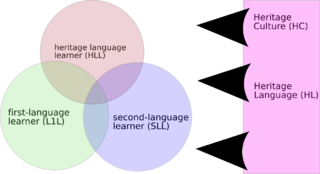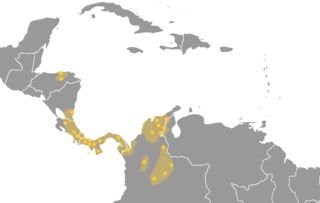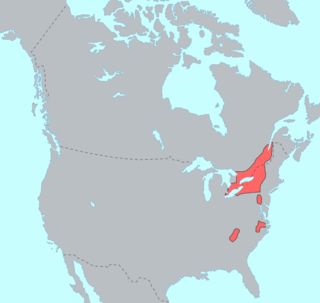
An endangered language, or moribund language, is a language that is at risk of falling out of use as its speakers die out or shift to speaking another language. Language loss occurs when the language has no more native speakers and becomes a "dead language". If no one can speak the language at all, it becomes an "extinct language". A dead language may still be studied through recordings or writings, but it is still dead or extinct unless there are fluent speakers. Although languages have always become extinct throughout human history, they are currently dying at an accelerated rate because of globalization, neocolonialism and linguicide.

An extinct language is a language that no longer has any speakers, especially if the language has no living descendants. In contrast, a dead language is "one that is no longer the native language of any community", even if it is still in use, like Latin. Languages that currently have living native speakers are sometimes called modern languages to contrast them with dead languages, especially in educational contexts.

The Chibchan languages make up a language family indigenous to the Isthmo-Colombian Area, which extends from eastern Honduras to northern Colombia and includes populations of these countries as well as Nicaragua, Costa Rica, and Panama. The name is derived from the name of an extinct language called Chibcha or Muysccubun, once spoken by the people who lived on the Altiplano Cundiboyacense of which the city of Bogotá was the southern capital at the time of the Spanish Conquista. However, genetic and linguistic data now indicate that the original heart of Chibchan languages and Chibchan-speaking peoples may not have been in Colombia at all, but in the area of the Costa Rica-Panama border, where one finds the greatest variety of Chibchan languages.
The following lists of endangered languages are mainly based on the definitions used by UNESCO. In order to be listed, a language must be classified as "endangered" in a cited academic source. Researchers have concluded that in less than one hundred years, almost half of the languages known today will be lost forever.
Language revitalization, also referred to as language revival or reversing language shift, is an attempt to halt or reverse the decline of a language or to revive an extinct one. Those involved can include parties such as linguists, cultural or community groups, or governments. Some argue for a distinction between language revival and language revitalization. It has been pointed out that there has only been one successful instance of a complete language revival, that of the Hebrew language, creating a new generation of native speakers without any pre-existing native speakers as a model.

The Iroquoian languages are a language family of indigenous peoples of North America. They are known for their general lack of labial consonants. The Iroquoian languages are polysynthetic and head-marking.

In linguistics, language death occurs when a language loses its last native speaker. By extension, language extinction is when the language is no longer known, including by second-language speakers. Other similar terms include linguicide, the death of a language from natural or political causes, and rarely glottophagy, the absorption or replacement of a minor language by a major language.
The thirty New Caledonian languages form a branch of the Southern Oceanic languages. Their speakers are known as Kanaks. One language is extinct, one is critically endangered, 4 are severely endangered, 5 are endangered, and another 5 are vulnerable to extinction.
The languages of Ethiopia refers to the various spoken forms of communication in Ethiopia. It includes the nation's official languages, its national and regional languages, as well as its minority and foreign languages.
An indigenous language or autochthonous language is a language that is native to a region and spoken by indigenous people. This language is from a linguistically distinct community that originated in the area. Indigenous languages are not necessarily national languages ; and national languages are not necessarily indigenous to the country.
Yuracaré is an endangered language isolate of central Bolivia in Cochabamba and Beni departments spoken by the Yuracaré people.
Bade is a West Chadic language spoken by the Bade people in Yobe State and Jigawa State, Nigeria. Their traditional ruler is the Emir of Bade. Similar to many other Western African languages, Bade is a vulnerable language at great risk of extinction. With 250,000 speakers, the language and the culture of the Bade people have suffered over the last several years. As the language continues to fade, the culture and historic value associated with the language perishes as well. The local dialect is shifting from Bade to Hausa. Across West Africa, the impact on local communities through the loss of the indigenous tongues will be significant. The endangerment of the Bade language represents the worldwide language diversity that is at risk. Many African languages have only received little linguistic attention, impacting these African languages.
Kogali-Samatu Kodihalli is a village in the southern state of Karnataka, India.
Zaramo is a Niger-Congo language, formerly primary language of the Zaramo people of eastern Tanzania. Zaramo is also known as Zalamo, Kizaramo, Dzalamo, Zaramu, Saramo and, Myagatwa. The language is critically endangered. The ethnic population of the Zaramo people reaches about 200,000, yet there are only a few elderly speakers remaining.
Dusner is a language spoken in the village of Dusner in the province of Papua, Indonesia. Dusner is highly endangered, and has been reported to have just three remaining speakers.
Lalo is a Loloish language cluster spoken in western Yunnan, China by 300,000 speakers. Speakers are officially part of the Yi nationality, and Chinese linguists refer to it as "Western Yi" due to its distribution in western Yunnan. Lalo speakers are mostly located in southern Dali Prefecture, especially Weishan County, considered the traditional homeland of the Lalo. Historically, this area is the home of the Meng clan, who ruled the Nanzhao Kingdom (737–902 CE). Many speakers of Core Lalo dialects claim to be descendants of the Meng clan.
The Lisoish languages are a branch of the Loloish languages proposed by Ziwo Lama (2012) that includes Lisu and several of the Yi languages. David Bradley (1997) considers Lisoish languages to be part of the Central Loloish branch.
Iyive, also referred to as Uive, Yiive, Ndir, Asumbos, is a severely endangered Bantoid language spoken in Nigeria and Cameroon. The ethnic group defined by use of this language is the Ndir.
Lamu is a highly endangered Loloish language of northeastern Binchuan County, Yunnan. According to Bradley (2007), the Lamo language is similar to Lisu and Lipo, although the speakers are classified by the Chinese government as ethnic Lahu. There are only about 100 speakers left, all of whom are also first-language speakers of Lipo. Lamo speakers were located by Bradley in 1999.







